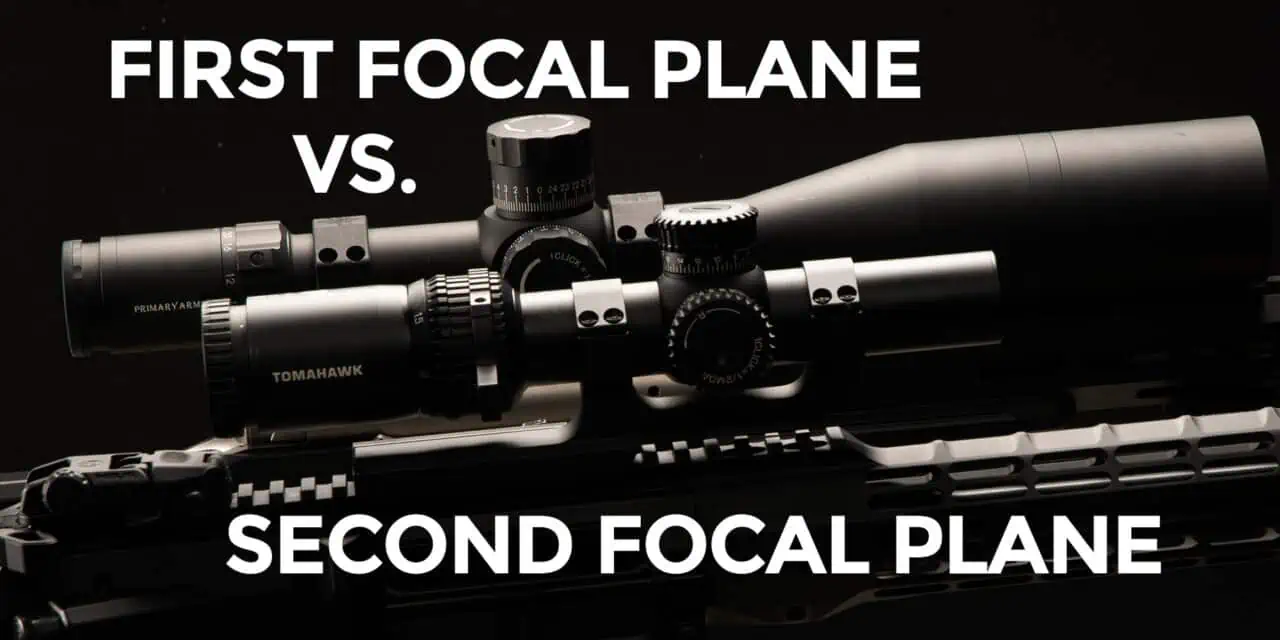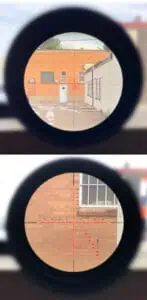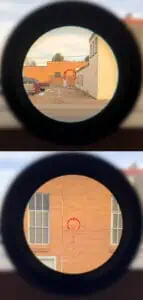Decoding First Focal Plane vs Second Focal Plane Optics
Deciding you need a scope on your rifle is one thing. Trying to figure out what features you need and what scope is best for you is something else. There are plenty of buzzwords used to describe what an optic does and how it might help you. Two phrases that are heard quite often are “first focal plane” and “second focal plane.” Let’s take a look at what those words actually mean. We’ll also look at some of the advantages of first focal plane vs second focal plane scopes, and why you might want to choose one over the other.
Fast Facts:
First Focal Plane vs Second Focal Plane
- A First Focal Plane Reticle rests in front of the magnifying portion of your optic, a Second Focal Plane Reticle rests behind it.
- First Focal Plane scopes work well for high magnification, long range scopes.
- Second Focal Plane Scopes are well-suited to low power variable zoom optics.
Let’s begin by looking at what’s inside a typical rifle scope. The reticle you see inside your scope is chemically etched into a thin, flat piece of glass inside your scope. That reticle is coated to make it easier for you to see. Where that reticle glass is located inside your scope is what makes the difference between first focal plane vs second focal plane scopes.
Magnify The Issue
A quick detour is needed to talk about magnification. There are two types of magnifying optics for your rifle, fixed power scopes, and variable power scopes. A typical fixed power scope is something like the classic ACOG rifle optic, which is always set at one level of magnification. Where the reticle is placed inside of a fixed power scope doesn’t really matter, as the power of the magnifier never changes.
A variable power optic, on the other hand, can change magnification power as you spin a dial or twist a ring on your scope. This ability to change the power of your optic affects how the reticle is magnified (or not) in your scope. This in turn creates a difference between a first focal plane vs second focal plane scope.
What’s Inside Each Optic
A First Focal Plane (FFP) scope places the reticle before the part of your scope that changes magnification, which increases the size of the reticle as you increase the magnification of your scope. As you zoom the power of your scope, your reticle gets bigger as well. What this does, in essence, is increase (or decrease) the size of the markings on your reticle at the same rate that the apparent size of the target changes in your field of view. This becomes important later on, but for now, let’s talk about Second Focal Plane scopes.
The reticle in a Second Focal Plane (SFP) scope is positioned behind the zoom element of the scope, and doesn’t change in size when you increase or decrease your magnification. As you zoom a Second Focal Plane scope, the size of the markings on your reticle will change relative to the size of the target.
Is The Target In Range?
This becomes important if you use your scope for estimating distances using the markings on your reticle, which are commonly done in either milliradians (MRAD) or minute of angle (MOA). If, for instance, you measure the size of the target using your reticle with a First Focal Plane scope, that reading you took (in either MRAD or MOA) will be consistent as you change the power of the optic. The reticle in an FFP scope changes size as the target changes size. This means, that a target that measures out as 8 MOA across will still be 8 MOA across, no matter which magnification you use.
This is not the case with a Second Focal Plane scope. Because the reticle doesn’t appear to change size as the size of the target changes in your scope, the reading you took at, say, 12 power can be quite different at 6 power. Most SFP scopes with MRAD/MOA markings have a set magnification where the reticle markings are accurate. This is usually at either at maximum magnification or at 10x (your scope’s instruction manual will tell you which it is).
Talking First Focal Plane vs Second Focal Plane With An Expert
I talked with Michael Branson, the Product Marketing Director at Swampfox Optics, to get some idea of when you’d want something in First Focal Plane vs a Second Focal Plane optic.
“If you’re shooting Precision Rifle or doing long-range hunting, a First Focal Plane scope is definitely the way to go,” Branson said. “The ability to estimate distance accurately using an MRAD or MOA reticle is absolutely vital in those environments. With an FFP scope, you don’t have to worry about what magnification you’re using when you make your call on target size and distance. The reticle doesn’t change its relative size to the target, no matter what magnification you use.”
“There are some disadvantages to a First Focal Plane scope,” Branson continued. “Because the size of the reticle grows smaller as you decrease magnification, it can get quite hard to see where your scope is lining up when you’re at minimum power. Also, because the reticle glass is smaller and harder to make correctly, it’s usually pricier to go with a First Focal Plane vs Second Focal Plane optic.”
Taking A Second Look At Second Focal Plane Optics
This, however, is half the story, so I asked Branson about the advantages and disadvantages of a Second Focal Plane riflescope.
“A Second Focal Plane optic works great in lower power magnifications, 10x and below,” Branson said. “They are great for use in a LPVO, or low power variable optic. Those types of scopes need a reticle that always looks the same and can be used for fast target acquisition. The size of the reticle in an SFP optic is always the same, making them ideal for this sort of thing. Also, if you’re shooting longer ranges, but are using something like a plain crosshairs that can’t estimate distance, then a Second Focal Plane scope will do just fine.”
“The downside to a Second Focal Plane optic is they’re really not optimized for long distance work. They also cost a bit less than an FFP scope, which can seem like a deal if you don’t watch out. As long as you understand what an SFP scope can and can’t do, though, there are some real bargains out there right now.”
It’s Not First Focal Plane Vs Second Focal Plane, It’s What You Want To Do With Your Optic
In the end, the advantages and disadvantages of First Focal Plane vs Second Focal Plane come down to your reasons for buying an optic. If you’re looking to reach out and touch something at 400 yards and beyond, an FFP scope makes a lot of sense, especially if you use your reticle markings to estimate distance. However, if you like a plain crosshair or duplex reticle, or if long range really isn’t your game, you might want to look into a Second Focal plane scope.
One of the big takeaways for me from talking with Branson and other people in the optics industry is just how high the quality of the optics being made right now is versus scopes made just a few years ago. Modern design methods and advanced manufacturing processes mean that today’s riflescopes have more features and clearer glass than those made just a decade ago. This means that no matter how you resolve the question of First Focal Plane vs Second Focal Plane, chances are, you’ll wind up with an optic that will perform as well (or better) than you can perform.




